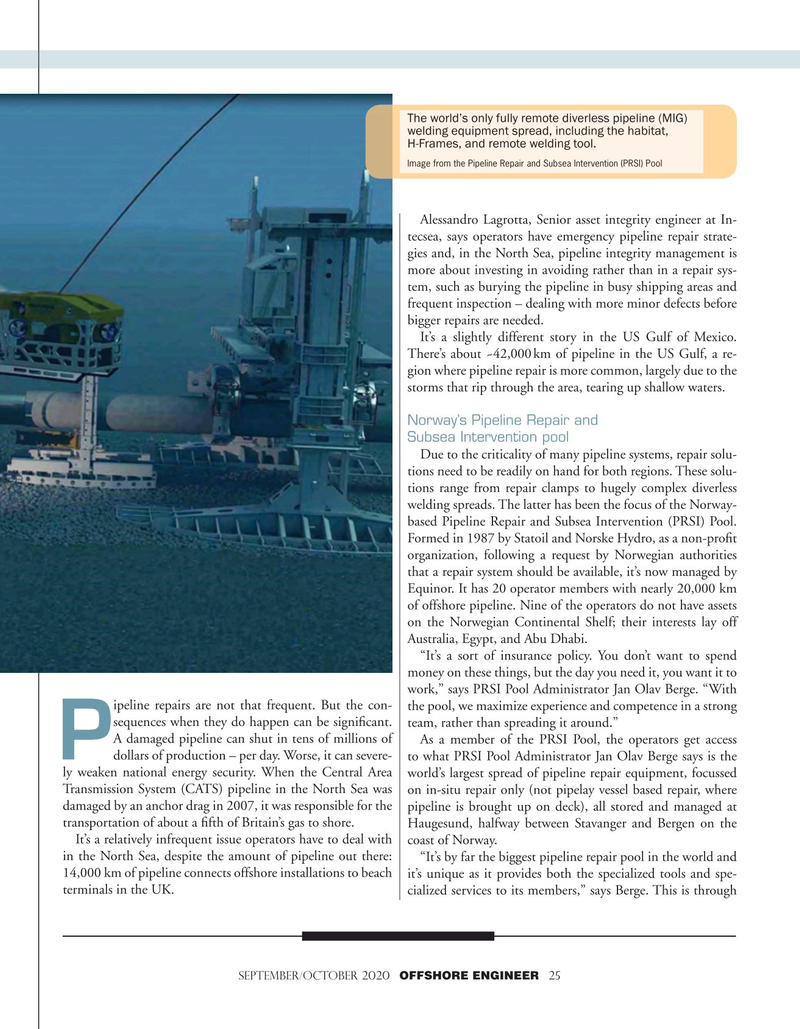
Page 25: of Offshore Engineer Magazine (Sep/Oct 2020)
Read this page in Pdf, Flash or Html5 edition of Sep/Oct 2020 Offshore Engineer Magazine
The world’s only fully remote diverless pipeline (MIG) welding equipment spread, including the habitat,
H-Frames, and remote welding tool.
Image from the Pipeline Repair and Subsea Intervention (PRSI) Pool
Alessandro Lagrotta, Senior asset integrity engineer at In- tecsea, says operators have emergency pipeline repair strate- gies and, in the North Sea, pipeline integrity management is more about investing in avoiding rather than in a repair sys- tem, such as burying the pipeline in busy shipping areas and frequent inspection – dealing with more minor defects before bigger repairs are needed.
It’s a slightly different story in the US Gulf of Mexico.
There’s about ~42,000 km of pipeline in the US Gulf, a re- gion where pipeline repair is more common, largely due to the storms that rip through the area, tearing up shallow waters.
Norway’s Pipeline Repair and
Subsea Intervention pool
Due to the criticality of many pipeline systems, repair solu- tions need to be readily on hand for both regions. These solu- tions range from repair clamps to hugely complex diverless welding spreads. The latter has been the focus of the Norway- based Pipeline Repair and Subsea Intervention (PRSI) Pool.
Formed in 1987 by Statoil and Norske Hydro, as a non-proft organization, following a request by Norwegian authorities that a repair system should be available, it’s now managed by
Equinor. It has 20 operator members with nearly 20,000 km of offshore pipeline. Nine of the operators do not have assets on the Norwegian Continental Shelf; their interests lay off
Australia, Egypt, and Abu Dhabi. “It’s a sort of insurance policy. You don’t want to spend money on these things, but the day you need it, you want it to work,” says PRSI Pool Administrator Jan Olav Berge. “With ipeline repairs are not that frequent. But the con- the pool, we maximize experience and competence in a strong sequences when they do happen can be signifcant. team, rather than spreading it around.”
A damaged pipeline can shut in tens of millions of As a member of the PRSI Pool, the operators get access dollars of production – per day. Worse, it can severe- to what PRSI Pool Administrator Jan Olav Berge says is the
P ly weaken national energy security. When the Central Area world’s largest spread of pipeline repair equipment, focussed
Transmission System (CATS) pipeline in the North Sea was on in-situ repair only (not pipelay vessel based repair, where damaged by an anchor drag in 2007, it was responsible for the pipeline is brought up on deck), all stored and managed at transportation of about a ffth of Britain’s gas to shore. Haugesund, halfway between Stavanger and Bergen on the
It’s a relatively infrequent issue operators have to deal with coast of Norway. in the North Sea, despite the amount of pipeline out there: “It’s by far the biggest pipeline repair pool in the world and 14,000 km of pipeline connects offshore installations to beach it’s unique as it provides both the specialized tools and spe- terminals in the UK. cialized services to its members,” says Berge. This is through
SEPTEMBER/OCTOBER 2020 OFFSHORE ENGINEER 25

 24
24

 26
26